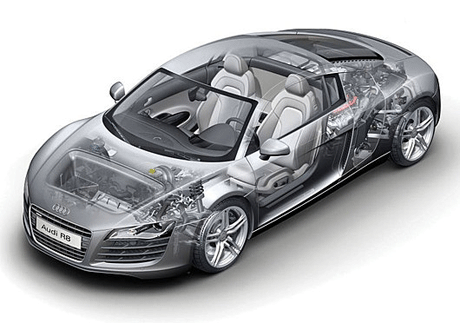Carlos at Cartype is putting together a gallery of car cut-away diagrams. I’m ever fascinated by how many parts go into making a car. Every little tiny piece has to be designed by someone and manufactured by someone. The precision required to make everything fit and function together reliably blows my mind.


Rick
on 28 Jan 08Shouldn’t there be a disclaimer that Segura Inc, the company behind Catype, was a former investor in 37signals?
jF
on 28 Jan 08Nothing needs to be disclaimed other than as a car lover I love Cartype.
Carlos was one of the original founders of 37signals in 1999. He left in 2000. He doesn’t have a penny invested in 37signals and hasn’t had anything to do with 37signals for nearly 8 years.
We’re best friends and that’s the extent of the connection.
l
on 28 Jan 08linkups to friends don’t need disclaimers. The post wasn’t pushing a product, or giving a review … it was simply saying check this out.
Freedom Sweaters
on 28 Jan 08David Kimble is sort of the godfather of cutaways. He lives in Texas and does the cutaway work by hand and overlays—I believe it takes him months to complete each one. GM and other manufacturers pay him $30,000 each for a detailed work on a vehicle.
Being that Kimble doesn’t do this digitally, it is no surprise that he is websiteless, but this should provide some context http://www.khulsey.com/masters_david_kimble.html
carlivar
on 28 Jan 08What’s more amazing is the design of cars 50 years ago. I would argue it’s easier now for two reasons: computers (of course) and the fact that cars don’t change much between individual model years. A Jetta is pretty much the same car between 2005-2009 or whatever (yes I know that’s probably not right).
But a 1956, 1957, 1958, and 1959 Chevy Bel-Air are all different. I guess there’s a reason the car companies moved away from those constant styling changes, but the Big Three did succeed in pushing out the smaller companies who could not afford to constantly redesign (Hudson, Studebaker, Packard, etc.).
I guess there’s the other side of the coin though. The VW Beetle was designed in the 1930’s and was still being produced just about into the 21st century with the same basic design. Hmm start simple, add small incremental improvements… was the VW Beetle the start of Agile Engineering?
Don Schenck
on 28 Jan 08Loving cars makes this a must-see!
Say … does that Audi have a special slot where you store the garage appointments??
grin
Gensior
on 28 Jan 08If you’re fascinated about how many parts go into cars, you should check out airplanes. The tolerances that go into building just the turbines, for example, are staggering.
Sadly, though, the commercial jet market isn’t geared towards the Average Joe, which would explain the lack of good advertisement-esque cutaways.
This is the best that I could find quickly.
raphael campardou
on 28 Jan 08I have this kind of fascination too. Anything complex reminds me of how dumb I am, how dumb we all are, as individuals. Only cumulative and continuous experience can produce a great level of complexity. Most of all, it reminds me how much we (I) need simplicity.
Gerlando
on 29 Jan 08Wow, I never knew there was a connection between Carlos and 37Signals. I’ve been in awe of Carlos and T26 since the early 90s, their fonts and design are amazing.
MiSc
on 29 Jan 08Back to the product:
Today’s cars are far too big, they need too much energy just to carry their own weight (which is far too heavy), they are gimps in terms of mobility (for parking manouvres the tyres are helplessly unmovable) and they pollute the air. Can’t we do any better? We can (shorter, higher, slower and quiet – e.g. check out Fredric Vester or Luigi Colani), but the industry is inflexible and numb and they produce far away from consumer’s needs, which they (us, the consumers) cannot really express, because they learned to take (buy) what they were given (sold).
Today’s cars aren’t something to love.
LB
on 29 Jan 08Another artist worth mentioning is Rony Lutz, working for Saab. Some of his drawings are available online.
carlivar
on 30 Jan 08Misc: today’s cars? Compare today’s cars (weight, parking maneuvers, pollution) to 40 years ago. Specifically take a look at, say, a 1968 Cadillac with a 500 cubic inch engine and probably about 19 feet long.
MiSc
on 30 Jan 08@carlivar: I don’t say it’s easy. But taking a look at the average car (not a cadillac), there’s a lot of room for improvement. How far did the evolution go the last 20 years – and how could it have been going?
Is today’s car the best way for mobility we can imagine?
This discussion is closed.